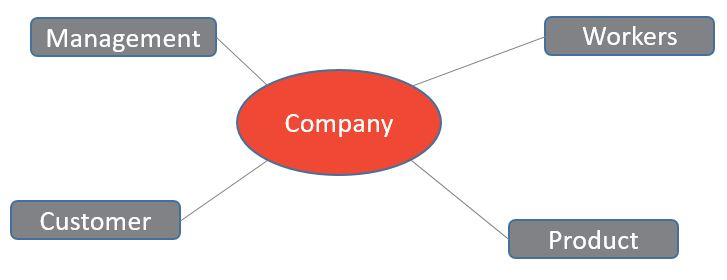I’ve started about 3 concept posts by now and I got stuck in each of them because I had to explain about silos. And when I start to explain about silos, somehow I have to drag the whole “history of automation” and “how companies grow” into it. So instead of fighting this, I decided to become a bit of a Stoic about it.
The impediment to action advances action. What stands in the way becomes the way.
— Marcus Aurelius
So here it is, my thoughts on silos. In follow-up posts I will detail the technical attempts that have been tried (and in my opinion have failed) to either bridge the divide between the silos or to remove the silos.
Anatomy of a company
In order to understand silos, you first have to understand how most companies are set up.
Pillars
Broadly speaking, companies can either make products, move products or provide services. So where it says ‘products’ in my model, you can read one of the above mentioned three options.

So in my model, a company makes products, it has customers (hopefully), workers who make the products and people that manage the work. I don’t want to make it more difficult for now because the result of this model is already a big mess as can been seen later on, but you can imagine more products, different kinds of customers, more management layers etc. But, like I said, lets start with these four simple pillars.
Processes
So around these pillars the company processes appear like magic. A quick brainstorm of what happens within and between each of these pillars resulted in the image below. Again, I’m probably missing a lot of things, but that’s allowed in a model, so bear with me. Worker make or move products, are hired or fired and go on holiday, Products are made in a machine and you need raw materials to make them with, etc. No rocket science, except if you make rockets.

The first hints of silo forming can be already seen and in “use of language” and “behavior of people”, the silos have probably always been in place, but the manifestation of the silos was amplified drastically by automation.
Start of automation
Here’s where I start with the history of automation. Go back with me to the seventies and eighties if you will. Remember those times? If not, ask your parents or grandparents. They’ll know. (There’s a great book series (in Dutch) called Het Bureau which describes in detail the goings-on in a company of around that period.)
They got to work, there was a bunch of unmade and unmoved stuff for them to do, and at the end of the day it was made and moved. There were letters to be written, invoices to be typed and if you wanted a duplicate, you had to use carbon paper in a typewriter to make a Carbon Copy (the CC in the email of today).
Then the first computers appeared on the scene, with big wheels of tape to make backups, and the dot matrix printer with its continuous form paper. Ah, the memories… At first, these computers were used to automate existing tasks, like typing one letter or making one invoice that you could print twice. Then somebody got the great idea to automate an entire area around a pillar, e.g. around the customer, and create a CRM system: the birth of (best of breed) systems.

Ah, now I can see the silos
And there they are: the silos, or as I like to call them, the happy bubbles of the employee. What’s wrong with these bubbles? People are happy in their bubble, aren’t they? Yes, they are, but they are also ignorant.
Ignorant? Now that’s a strong word!
Yes, it is, but I don’t mean they are stupid. They know everything that goes on in their bubble, every detail even, but they don’t know anything that goes on outside of their bubble, and what’s worse: they do not care! Their bubble is everything to them.
Why is that a problem?
It’s a problem because the world has moved on since the eighties and it changes faster and faster. Big bubbles cannot change fast and sometimes can’t change at all. Supply chains have crossed borders! Customers don’t want to wait for something great. They want it now and can get it now somewhere else as easy as changing their underwear!
Within a company all sorts of things get a sensor, and these sensors throw more and more measurements which can be reported on, meaning management can shift direction to a more desirable course. We can no longer wait for the bubbles to adjust in their own sweet time, we need to pop them ASAP and share information!
Popping bubbles
So, how do we pop these bubbles? Good of you to ask. But as always, I’ll first explain what has been tried in the past. For this, I will also need a couple of posts as well. Here’s a sneak preview:
- First Attempt: Enterprise Application Integration (EAI)
- Second Attempt: Automation of Business Processes (BPM)
- Third Attempt: Common Data Model (CDM)
- Fourth Attempt: Service Oriented Architecture (SOA)
- Fifth Attempt: Micro Services
- Sixth attempt: who knows…





